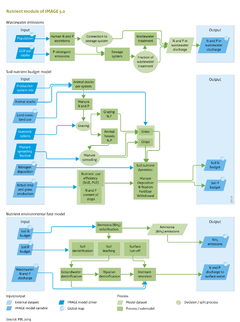Nutrients/Description: Difference between revisions
Jump to navigation
Jump to search
No edit summary |
No edit summary |
||
| Line 55: | Line 55: | ||
# the approach includes the effect of pH on denitrification. | # the approach includes the effect of pH on denitrification. | ||
==== | ====Nutrients from vegetation in floodplains==== | ||
NPP from the LPJ model [[Carbon cycle and natural vegetation]] for wetlands and floodplains are used. Part of annual NPP is assumed to be deposited in the water during flooding, and where flooding is temporary, the litter from preceeding periods is assumed to be available for transport in the flood water. 50% of total NPP is assumed to end in the surface water. | NPP from the LPJ model [[Carbon cycle and natural vegetation]] for wetlands and floodplains are used. Part of annual NPP is assumed to be deposited in the water during flooding, and where flooding is temporary, the litter from preceeding periods is assumed to be available for transport in the flood water. 50% of total NPP is assumed to end in the surface water. | ||
====Other sources==== | ====Other direct sources of nutrients==== | ||
Other sources include aquaculture, weathering and atmospheric deposition. Deposition is from the same data as used for the land nutriënt budgets. Aquaculture is taken from data from two recent studies ([[Bouwman et al., 2011]]; [[Bouwman et al., 2013c]]), and weathering. The calculation of P release from weathering is based on a recent study ([[Hartmann et al., 2014]]) which uses the lithological classes distinguished by ([[Dürr et al., 2005]]). The lithological classes are available on a 5 by 5 minute resolution, hence the weighted average P concentration within each 0.5 by 0.5 degree grid cell is calculated. | Other sources include aquaculture, weathering and atmospheric deposition. Deposition is from the same data as used for the land nutriënt budgets. Aquaculture is taken from data from two recent studies ([[Bouwman et al., 2011]]; [[Bouwman et al., 2013c]]), and weathering. The calculation of P release from weathering is based on a recent study ([[Hartmann et al., 2014]]) which uses the lithological classes distinguished by ([[Dürr et al., 2005]]). The lithological classes are available on a 5 by 5 minute resolution, hence the weighted average P concentration within each 0.5 by 0.5 degree grid cell is calculated. | ||
Revision as of 15:23, 2 November 2016
Parts of Nutrients/Description
| Component is implemented in: |
| Components: |
| Related IMAGE components |
| Projects/Applications |
| Key publications |
| References |
